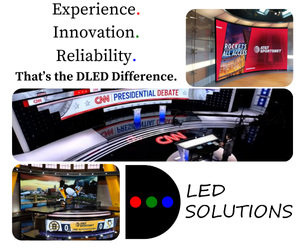IBC 2025 Preview: Sports broadcasters reimagine fan engagement for streaming era

Subscribe to NCS for the latest news, project case studies and product announcements in broadcast technology, creative design and engineering delivered to your inbox.
As streaming platforms proliferate and audiences fragment across multiple devices and platforms, sports broadcasters arriving at IBC 2025 face a fundamental challenge: how to maintain and deepen fan engagement in an increasingly saturated digital environment.
Traditional broadcast models built around passive viewing are giving way to interactive, personalized experiences that blur the lines between consumption and participation.
The industry is discovering that the next generation of sports fans expects more than just alternate camera angles or statistical overlays.
They want immersive experiences, personalized content and continuous engagement that extends far beyond live events. This shift is forcing broadcasters to completely rethink their relationship with audiences and develop new revenue models that serve both traditional viewers and emerging digital-native segments.
Multi-screen culture drives new engagement models
The modern sports viewing experience has fundamentally changed, with fans increasingly consuming content across multiple devices while simultaneously engaging with social media and interactive platforms. This shift represents both a challenge and an opportunity for broadcasters seeking to maintain audience attention.
“We’re moving into a multi-screen culture where data, interactivity, and gamification play a central role in fan engagement,” said Mark Cooke, VP of sales in EMEA at Ross Video. “Fans are no longer just watching; they want to engage with the game in real time, whether that’s through stats, fantasy leagues or interactive second-screen platforms.”
Research supports this behavioral shift.
According to Ross Video’s report “A Definitive Guide to the Modern Sports Viewer,” while 64% of fans still prefer traditional TV, almost a third now watch on smartphones or tablets, and 17% follow multiple sporting events simultaneously. The data reveals that 31% of European viewers message friends during games while browsing social media, indicating that community engagement has become integral to the viewing experience.
“What’s important is creating experiences that make fans feel part of the action,” Cooke said. “Whether that’s leaderboards, real-time predictions, or community-driven interactivity.”
The challenge for broadcasters is addressing the generational divide in viewing preferences while maintaining broad appeal.
“Traditional fans 35 and older are still committed to watching the entirety of a match or game. Whereas younger generations consume sport in shorter, varied formats,” Cooke said. “We need to be relevant to both.”
Immersive technologies promise transformative experiences
The next frontier in fan engagement involves technologies that transport viewers from passive observation to active participation. Virtual and augmented reality platforms are evolving from experimental novelties to viable commercial platforms that can deliver premium experiences at scale.
“The next generation of fan engagement is about to leap from 2D screens into fully immersive, 3D worlds where every seat is front-row,” said Lucy Trang Nguyen, business development director at Accedo. “Millions of fans will experience the action as if they’re in the stadium, with the freedom to explore, interact, and connect with their heroes.”
These immersive experiences also create new opportunities for brand integration and sponsorship activation, potentially transforming the economics of sports broadcasting.
“This opens the door to rich, interactive brand storytelling — turning every moment into a touchpoint for deeper loyalty, sponsorship activations, and new revenue streams,” Nguyen said.
Other industry leaders see fan control and customization as the key differentiator in saturated streaming markets.
“The future of fan engagement is about giving viewers more control,” said Ian Godfrey, CTO of TSL. “Not just picking from a few alternate feeds from static positions but actually being able to choose which camera angle or mic they want to follow. Essentially creating their own version of the event in real time.”
Continuous engagement models emerge
Beyond live event viewing, sports broadcasters are developing always-on engagement models that maintain audience connection throughout the year. These continuous streaming approaches blend live coverage with complementary content to create sustained value propositions.
“We’re entering an era of continuous streaming for leagues and even individual teams, where fans can tune in on their own time for a steady stream of content,” said Kathleen Barrett, CEO of Backlight. “These always-on channels blend live coverage with digital watch parties, real-time chat, merch integration, behind-the-scenes storytelling, and curated archival footage.”
Premium experiences within these continuous models are becoming more sophisticated, incorporating immersive technologies that bring fans closer to the action.
“Premium experiences are evolving too, with immersive AR and VR courtside offerings bringing fans closer to the action,” Barrett said.
Personalization and accessibility drive deeper connections
Artificial intelligence and machine learning technologies are enabling unprecedented levels of content personalization, allowing broadcasters to tailor experiences to individual fan preferences and viewing habits.
“Leading organizations are also testing personalized recaps tailored to individual fan preferences — by favorite team, player, content style, and even preferred length — so fans can catch up in 30, 60, or 90 seconds, or dive deeper when they want more,” Barrett said.
The goal is creating more relevant, frequent touchpoints that maintain engagement between major events.
“It’s a new model for sustained fan connection — delivering more relevance, more often, with measurable business impact,” Barrett said.
Artificial intelligence is also being leveraged to create hyper-personalized content experiences that merge multiple data streams in real time.
“AI will excel as a creative augmentation platform for fan engagement,” said David Jorba, chief business and strategy officer at Emergent. “It can generate automated, hyper-personalized content feeds by merging live video, real-time data, and visualization analytics to create unique viewer experiences.”
Forward-thinking broadcasters are recognizing that accessibility features represent strategic opportunities rather than compliance requirements. Advanced technologies are making it easier than ever to serve diverse global audiences with localized, accessible content.
“In today’s broadcasting, accessibility is a strategy, not charity,” said Ross Tanner, senior vice president EMEA at Magnifi. “Multilingual subtitles, inclusive UX, and culturally responsive formats unlock new audiences and overlooked revenue.”
Generative AI tools are accelerating this trend by automating the creation of accessible content enhancements.
“With GenAI-led tools now creating instant, context-aware enhancements to content, it has never been easier to accommodate everyone,” Tanner said.
Rights fragmentation creates new opportunities
As sports rights become increasingly fragmented across multiple platforms and distribution channels, broadcasters are developing more flexible engagement models that adapt to changing consumer preferences and viewing patterns.
“Fan engagement is evolving into a deeper value exchange that extends beyond the screen — incorporating exclusive content, loyalty rewards, interactive commerce, cross-platform interactions such as video game drops and even in-venue benefits for sports audiences,” said Craig Ferguson, director of regional sales Europe at Evergent.
This evolution is driving experimentation with new subscription and access models that provide more flexibility for both broadcasters and consumers.
“Rights holders are experimenting with match-specific passes, highlights-only tiers, and flexible pause-and-resume access to keep fans engaged year-round,” Ferguson said.
Advanced advertising technologies are creating new revenue opportunities within enhanced fan experiences, using artificial intelligence to identify optimal moments for contextually relevant content integration.
“Monetization is improved by introducing new inventory via advanced in-stream ad formats within live sports content and by using AI to identify high-value moments for dynamic insertion of contextually relevant ads that amplify brand awareness and boost revenue,” said Eric Gallier, vice president of video solutions at Harmonic.
The integration of e-commerce and interactive features within viewing experiences is creating additional revenue streams that extend beyond traditional advertising models.
As industry professionals prepare for IBC 2025, the conversation around fan engagement will likely focus on practical implementations of immersive technologies, sustainable personalization strategies and new revenue models that serve fragmented audiences effectively.
The challenge facing sports broadcasters is not just technological but cultural: how to maintain the communal experience that makes sports compelling while delivering the personalized, interactive experiences that modern audiences expect.
Success will require balancing innovation with the fundamental human elements that make sports broadcasting emotionally resonant.
The industry’s future depends on creating experiences that feel both cutting-edge and authentically connected to the sports and stories that fans love. As the streaming environment continues to evolve, those who can deliver meaningful engagement beyond the traditional viewing experience will define the next era of sports broadcasting.
Subscribe to NCS for the latest news, project case studies and product announcements in broadcast technology, creative design and engineering delivered to your inbox.






tags
Accedo, accessibil, Backlight, Craig Ferguson, David Jorba, Emergent, Eric Gallier, Evergent, Harmonic, Ian Godfrey, IBC 2025, Immersive Media, Kathleen Barrett, Lucy Trang Nguyen, Magnifi, Mark Cooke, Personalization, Ross Tanner, Ross Video, TSL, TSL Products
categories
Heroes, IBC Show, Sports Broadcasting & Production